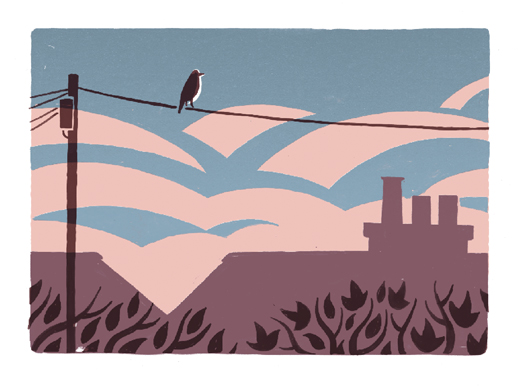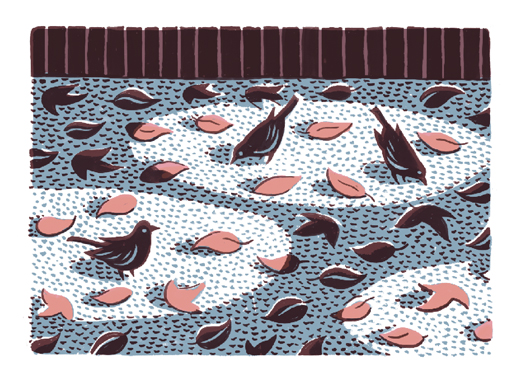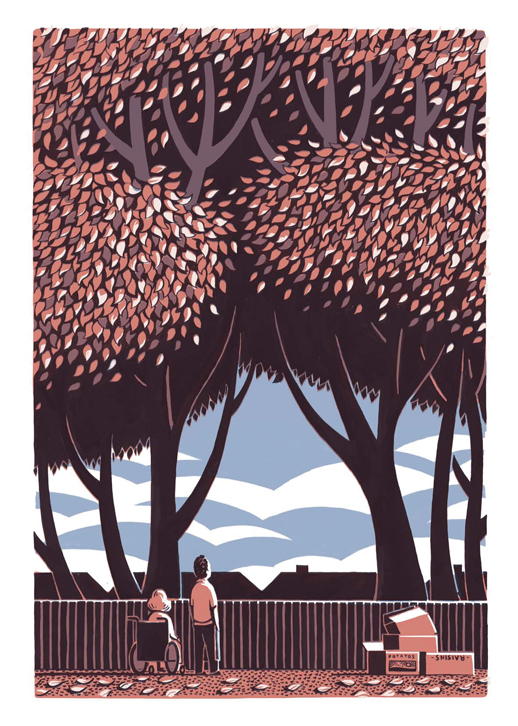Caught by the River’s friend and contributor, Jon McNaught, has his new book, Dockwood, published this week. We sent fellow artist (and Caught by the River contributor) Jamie Lewis to ask him some questions:
So tell me about the town of Dockwood?
Dockwood is a made-up town, but I want it to feel quite recognisable and unremarkable, similar to where I live now (in Bristol), or places I’ve lived in the past. A lot of the detail in the book comes from notes I make on my phone while I walk to work or around the town; stuff like billboards, particular trees, garden features, compositions of litter and things, anything that catches my eye.
My other two books are each about a specific location (Birchfield Close is about a quiet Cul de Sac, Pebble Island is about a small rural island) So Dockwood kind of completes the trio of places that I’ve lived in.
The design of the book, and a lot of the imagery seems to suggest a traditional British nature book, is this something that you intended?
I started coming up with ideas for this book while I was drawing the illustrations for Caught by the River’s On Nature book, and was doing a lot of research into nature illustration and traditional British pastoral art. What I really liked about the Caught by the River book was that it was nature writing, but coming from more of a human perspective…
Like more of a personal experience of nature?
Yeah, and often in surprising settings; it felt real, like a nice broad picture of the English countryside, and maybe slightly less romantic than you might be used to. As I was working on illustrating that book, I started planning some stories, and sort of playing on this idea. I was really enjoying making this nature-based imagery, but trying to relate it more to my own environment; looking at the daily things that I might see. I started to build up a bunch of ideas for a book that started as very much a nature themed book, and then meandered off into something quite different.
Well, you’ve taken it out of the countryside…
One of the things I’ve always really liked about good nature art or writing, is how it can capture the sense of being in an environment in all its detail at a moment in time. I guess I’ve been attempting to use comics for this purpose, hopefully getting across the feeling of a contemporary small British town. I tried to put as much care into the drawing of the urban aspects of the environment as the natural ones.
All the character’s are working as we follow them through their stories, there’s the nursing home, and the paper round… what’s the purpose of these work environments in the comic?
The locations are all based on jobs I’ve held in the past, I’ve spent a good few years working in kitchens, including a number of years in a nursing home kitchen, and also spent my teens doing paper-rounds after school. I was interested in doing something about the rhythm of those jobs – so there’s a lot of trundling in the book, either pushing along a tea trolley or hotplate, or pulling along a paper trolley. It was quite important to me that the narrative of the stories mainly just follows the duties of the job, to make the emphasis settle more on the little details of the environment….
So you’re trying to show the things that are interesting about a completely normal workday?
Yeah, I kind of started out with the intention of just trying to make as vivid an account as I could of a shift at a job, focusing on all the little details of the environment, from the nature outside to the rhythm of the dishwasher and the adverts on TV. It’s this muddle of things all existing in one place, and that’s what I wanted the book to be like really, just this collection of details and places sitting side by side and taking part in the narrative, kind of a celebration of this muddle.
One of the publicity quotes I read for your book refers to your work as being “poetry in comics”. Is this something that you see in your work?
I think a lot of comics, and certainly the comics that I’m most interested in often have a bit more in common with poetry than they do with say novels or short stories.
In what way?
Well, I think there can be quite a similarity between the layout of a page of comic strip panels and a page of poetry; the way a comic often has to stick to a structure of 4 or 5 panels in a row repeated down a page, often with an emphasis on symmetry, or repetition and visual rhyming. It’s a careful stitching together of different elements to try to get across the sense of a moment in time or of a thought or feeling, so in this way I guess there’s definitely a connection.
Has your creative process changed much working on this latest book?
The pages are all drawn out by hand using a brush and black ink on 2 or 3 separate overlays for each page (A separate sheet for each colour). When I began making comic books, I started printing them on my own either with screen-printing or offset lithography (I work as a technician at a print centre, so used the presses after work). When I met Alex and Sam at Nobrow, they encouraged me to expand and finish up a couple of the books that I was working on, and they printed them with the method that they use of commercial spot colour printing (I probably would not have printed more than a dozen if they hadn’t stepped in). Now the artwork is produced directly for this process, but in much the same way as I produced it when I printed it myself… It’s quite a long-winded approach, but the one I feel most comfortable with.
So what’s next?
I’m starting to work on some new prints at the moment, mainly quite rainy scenes as we’re seeing a lot of that at the minute, but I’ll start playing about with some more stories soon. Hopefully I’ll make some more stories about Dockwood before too long, but we’ll have to see how it all goes.
Dockwood is on sale in the Caught by the River shop, priced £13.


